Photos by T.R. Van Devender unless otherwise credited

Anna’s hummingbird (Calypte anna) is one of the few winter-breeding hummingbirds. It has an unusual distribution that was historically centered in California with winter migrants in Arizona. Later it’s range has expanded into Sonora south as far as Guaymas and Puerto Peñasco from September through April. Anna’s hummingbird is often an urban species that appears soon after feeders are provided. In the Yécora area it has been seen in December visiting tree morning glory (Ipomoea arborescens) in tropical deciduous forest and in September on Mesa del Campanero visiting Texas betony (Stachys coccinea). Photo: K. Krebbs at ASDM.
|
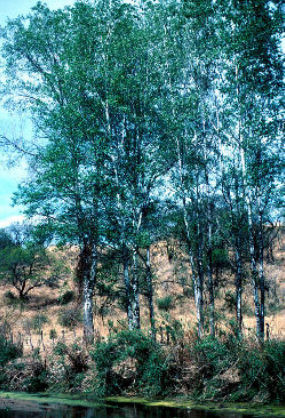
Arroyo Los Huérigos is a stream in a tropical deciduous forest canyon at 650 m elevation just east of Tepoca. Huérigo (Populus monticola) is the common name of a cottonwood that is found in southern Baja California and east-central Sonora. It was used as a surrogate for the heat-intolerant quaking aspen (P. tremuloides) in the Mountain Woodland exhibit at ASDM. A total of ten species of hummingbirds were seen in tropical deciduous forest along the Tónichi-Yécora transect.
|
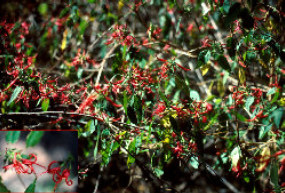
A dense stand of limita (Anisacanthus andersonii) attracts many hummingbirds in the spring. This shrub with bright red flowers is almost endemic to the eastern half of Sonora and was described as a new species only in 1982 by Tom Daniel, Curator of Botany at the California Academy of Sciences in San Francisco. Limita is worthy of cultivation.
|
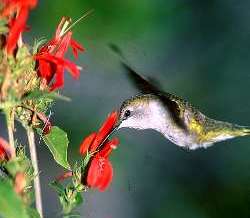
Costa’s hummingbird (Calypte costae) are common residents in tropical deciduous forest. This female is visiting Justicia candicans flowers. Photo: J. Flynn |
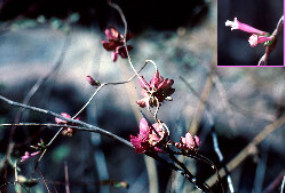
The wild jícama (Ipomoea bracteata) was a surprisingly important plant, visited by many species of hummingbirds. It is a woody vine from a large underground root that can climb ten meters into trees. Small purple flowers emerge from purplish bracts when the vine is leafless in spring. |
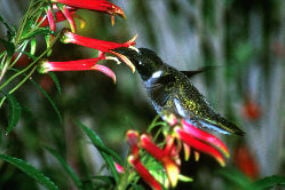
The black-chinned hummingbird (Archilochus alexandri) is a long distance migrant that passes through Sonora twice a year. In the spring, northward bound black-chins visit a variety of flowers such as the lobelia (Lobelia laxiflora) pictured here. However, there are few flowers except for tree tobacco (Nicotiana glauca) in the lowland valleys in August and September. In those areas black-chins must be utilizing fat reserves or eating insects to fuel their southward migration. Its relative Lobelia cardinalis occurs at higher elevations. Photo: K. Krebbs at ASDM. |
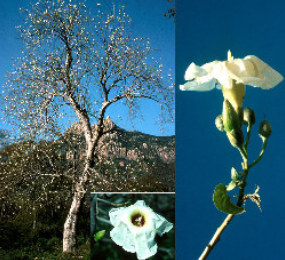
Tree morning glory (Ipomoea arborescens) is common in both thornscrub and tropical deciduous forest and is a major hummingbird food plant in both communities. Photos: left: S.A. Meyer; right: C.D. Bertelsen; inset: T.R. Van Devender. |
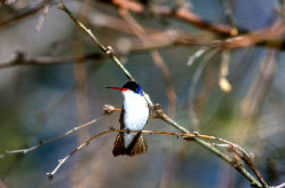
The violet-crowned hummingbird (Amazilia violiceps) is a common visitor to tree morning glory and tree tobacco in tropical deciduous forest. Unlike most other hummingbirds in Sonora, the coloration of males and females are very similar. Photo: K. Krebbs at Rancho La Mula, Sonora. |
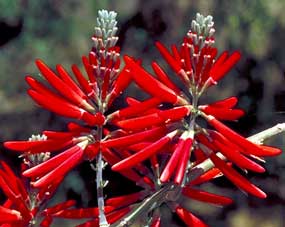
Coral-bean (chilicote, Erythrina flabelliformis) is only locally common, but is visited by hummingbirds wherever it blooms. Photo: Mark Dimmitt |
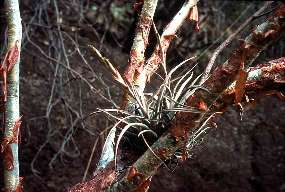
Tillandsia elizabethae (magueyito) is an epiphytic bromeliad of more humid microhabitats in Sonora and Sinaloa. The tubular blue flowers emerge from pink bracts that attract hummingbirds. Several more tillandsias occur in southern Sonora, and T. exserta grows on the desert coast. Photo: M.B. Johnson |
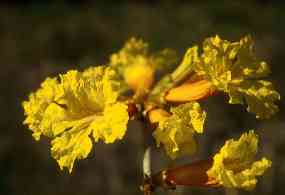
Tabebuia chrysantha (shown here) and T. impetiginosa are mainly bee-pollinated, but hummingbirds do not ignore the abundant flowers in late winter. Photo: G.M. Ferguson (main frame); inset (above): Mark Dimmitt |
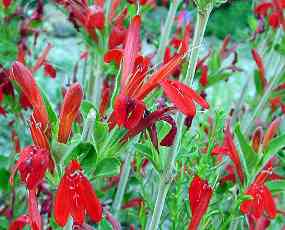
Justicia candicans occurs from TDF and thornscrub, and occasionally in the desert. It is not common anywhere that we know of, but it flowers from fall through spring and is thus an important hummingbird nectar source. Photo: Mark Dimmitt |
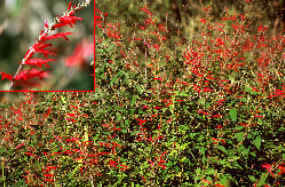
Pineapple sage (Salvia elegans), named for the odor of its crushed leaves, is a widely cultivated garden plant in the United States. It is locally common in Sierra Madre tropical canyons. Photos: K. Krebbs. |
|